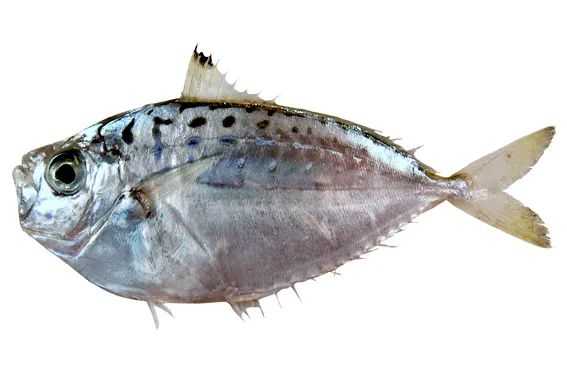
Secutor insidiator, commonly known as the broad - bodied ponyfish, is a remarkable species within the Leiognathidae family and the Secutor genus. Inhabiting the warm waters of the Indo - West Pacific region, this fish is recognized for its unique physical traits and ecological role in coastal and marine ecosystems.
Growing up to 16.5 centimeters in length, the broad - bodied ponyfish features an oval - shaped, laterally compressed body. The dorsal and ventral profiles are quite similar in curvature. It has a distinct appearance with a silvery - gray back and a white - silver belly. Irregular black spots or circles adorn its sides, creating an eye - catching pattern. The head is scaleless, while the body is covered with cycloid scales, except for a banded area from the base of the pectoral fin upwards to the base of the soft - rayed part of the dorsal fin and downwards to the origin of the anal fin. It has a short snout, shorter than the diameter of its eyes. The mouth is small and can protrude forward like a tube. The upper jaw has a row of sharp teeth, with a canine tooth at each front end, and the lower jaw also has some canine teeth. The dorsal fin is single, with the spiny part and the soft - rayed part connected. The pectoral fins are well - developed and sickle - shaped, and the caudal fin is deeply forked, enabling agile movement in the water.
This species primarily inhabits sandy - muddy bottom coastal areas. It is a schooling fish, usually active near the seabed, and can be found at depths of up to 40 meters. As a carnivorous predator, it feeds on small fish larvae, tiny crustaceans, and polychaete worms. Its diet helps regulate the population of these small organisms in the marine environment.
Distributed across the tropical waters from Sri Lanka in the west to the Micronesian Islands in the east, and from the South China Sea in the north to Papua New Guinea in the south, the broad - bodied ponyfish has economic significance. Its tender flesh makes it suitable for cooking, especially for making soups. Additionally, it is often used as bait in long - line fishing or fed to high - value aquaculture fish as low - value by - catch. However, like many coastal species, it may face threats from habitat degradation due to coastal development and pollution. Conservation efforts focused on protecting coastal habitats are crucial to ensure the long - term survival of this unique broad - bodied ponyfish and maintain the balance of the marine ecosystems it inhabits.




